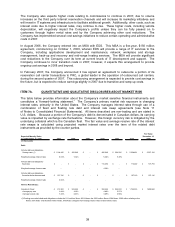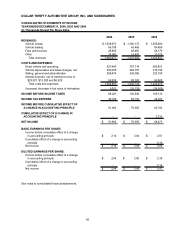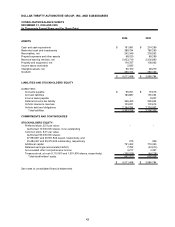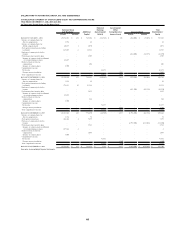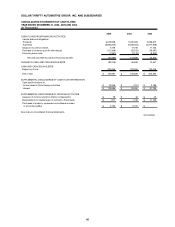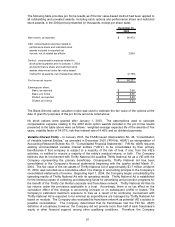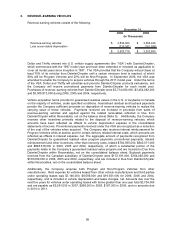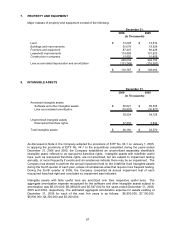Thrifty Car Rental 2006 Annual Report Download - page 55
Download and view the complete annual report
Please find page 55 of the 2006 Thrifty Car Rental annual report below. You can navigate through the pages in the report by either clicking on the pages listed below, or by using the keyword search tool below to find specific information within the annual report.Derivative Instruments – The Company uses SFAS No. 133 “Accounting for Derivative
Instruments and Hedging Activities”, as amended (“SFAS No. 133”), which requires that all
derivatives be recorded on the balance sheet as either assets or liabilities measured at their fair
value, and that changes in the derivatives’ fair value be recognized currently in earnings unless
specific hedge accounting criteria are met. Beginning in 2001 and continuing through 2006, the
Company entered into interest rate swap agreements. These interest rate swap agreements do not
qualify for hedge accounting treatment under SFAS No. 133; therefore, the changes in the interest
rate swap agreements’ fair values have been recognized as an (increase) decrease in fair value of
derivatives in the consolidated statement of income (Note 11).
Vehicle Insurance Reserves – Provisions for public liability and property damage and
supplemental liability insurance (“SLI”) on self-insured claims are made by charges primarily to
direct vehicle and operating expense. Accruals for such charges are based upon actuarially
determined evaluations of estimated ultimate liabilities on reported and unreported claims, prepared
on at least an annual basis. Historical data related to the amount and timing of payments for self-
insured claims is utilized in preparing the actuarial evaluations. The accrual for public liability and
property damage claims is discounted based upon the actuarially determined estimated timing of
payments to be made in the future. Management reviews the actual timing of payments as
compared with the annual actuarial estimate of timing of payments and has determined that there
have been no material differences in the timing of payments for each of the three years in the period
ended December 31, 2006. Because of less predictability, self-insured reserves for SLI are not
discounted.
Foreign Currency Translation – Foreign assets and liabilities are translated using the exchange
rate in effect at the balance sheet date, and results of operations are translated using an average
rate for the period. Translation adjustments are accumulated and reported as a component of
accumulated other comprehensive income.
Income Statement Presentation – The Company has not separately disclosed the costs and
expenses related to its company-owned and franchised operations that correspond with the
Company’s revenue-generating activities such as vehicle rental and vehicle leasing reflected in the
Consolidated Statements of Income since certain of such costs and expenses have not been
separately identified in the Company’s financial systems, and it is not practicable to separate or
disclose them in a reasonable and consistent manner.
Revenue Recognition – Revenues from vehicle rentals are recognized as earned on a daily basis
under the related rental contracts with customers. Revenues from leasing vehicles to franchisees
are principally under operating leases with fixed monthly payments and are recognized as earned
over the lease terms. Revenues from fees and services include providing sales and marketing,
reservations, information systems and other services to franchisees. Revenues from these services
are generally based on a percentage of franchisee rental revenue or upon providing reservations
and are recognized as earned on a monthly basis. Initial franchise fees, which are recorded to other
revenues, are recognized upon substantial completion of all material services and conditions of the
franchise sale, which coincides with the date of sale and commencement of operations by the
franchisee.
Advertising Costs – Advertising costs are primarily expensed as incurred. The Company incurred
advertising expense of $37,584,000, $35,269,000 and $36,664,000, for 2006, 2005 and 2004,
respectively.
Thrifty’s primary advertising is conducted by a historically unconsolidated affiliated entity, Thrifty
National Ad. The Company began consolidating the operations of Thrifty National Ad effective April
1, 2004, in accordance with Financial Accounting Standards Board (“FASB”) Interpretation No.
46(R) (See “Variable Interest Entity”). Thrifty made payments of $2,162,000 in the first quarter of
2004 to Thrifty National Ad to support funding of advertising campaigns, which are included in
advertising costs. Thrifty also received reimbursement from Thrifty National Ad for administrative
services such as information technology and accounting services, totaling $733,000 in the first
quarter of 2004 which are recorded as offsets to selling, general and administrative expense. The
49


